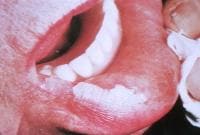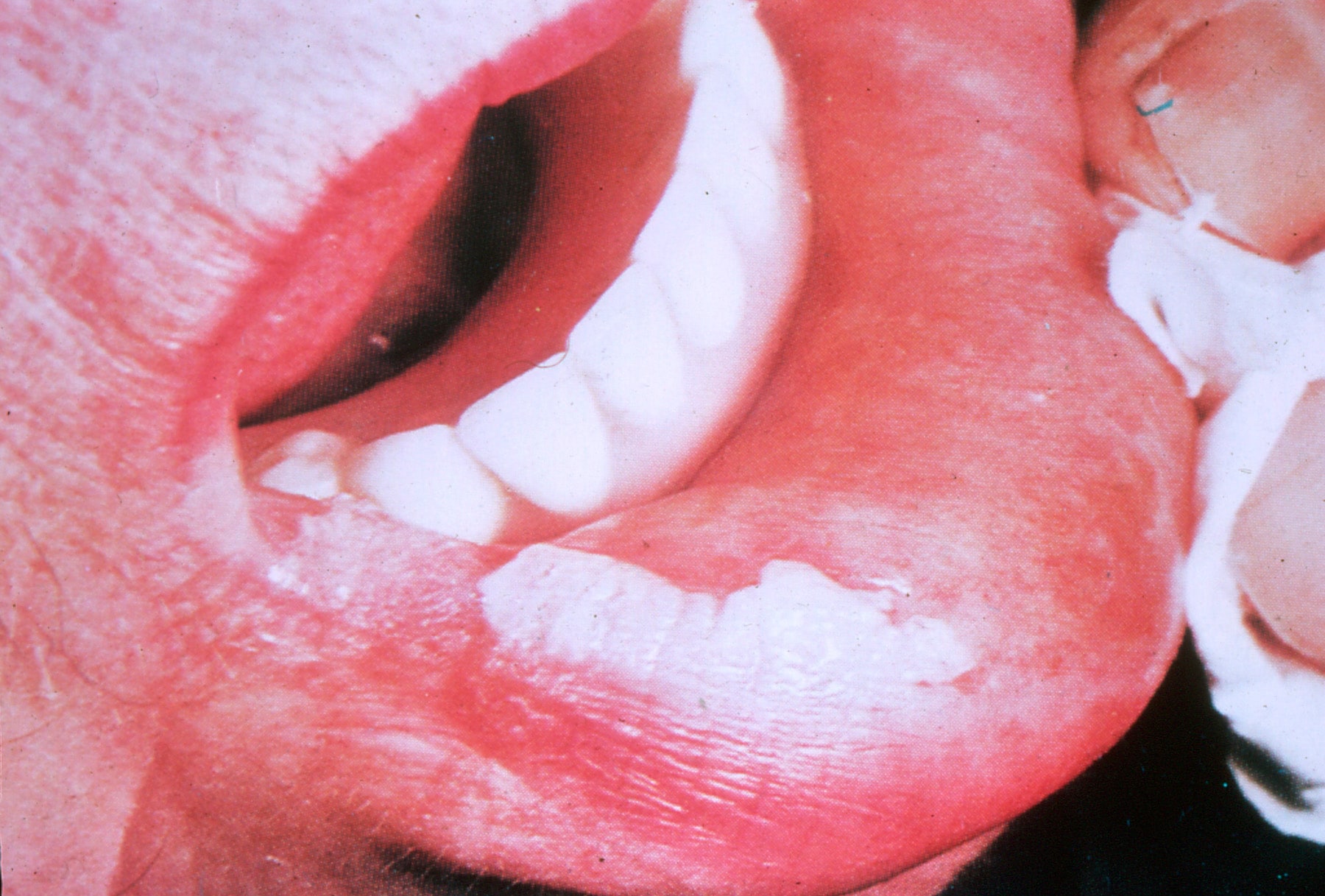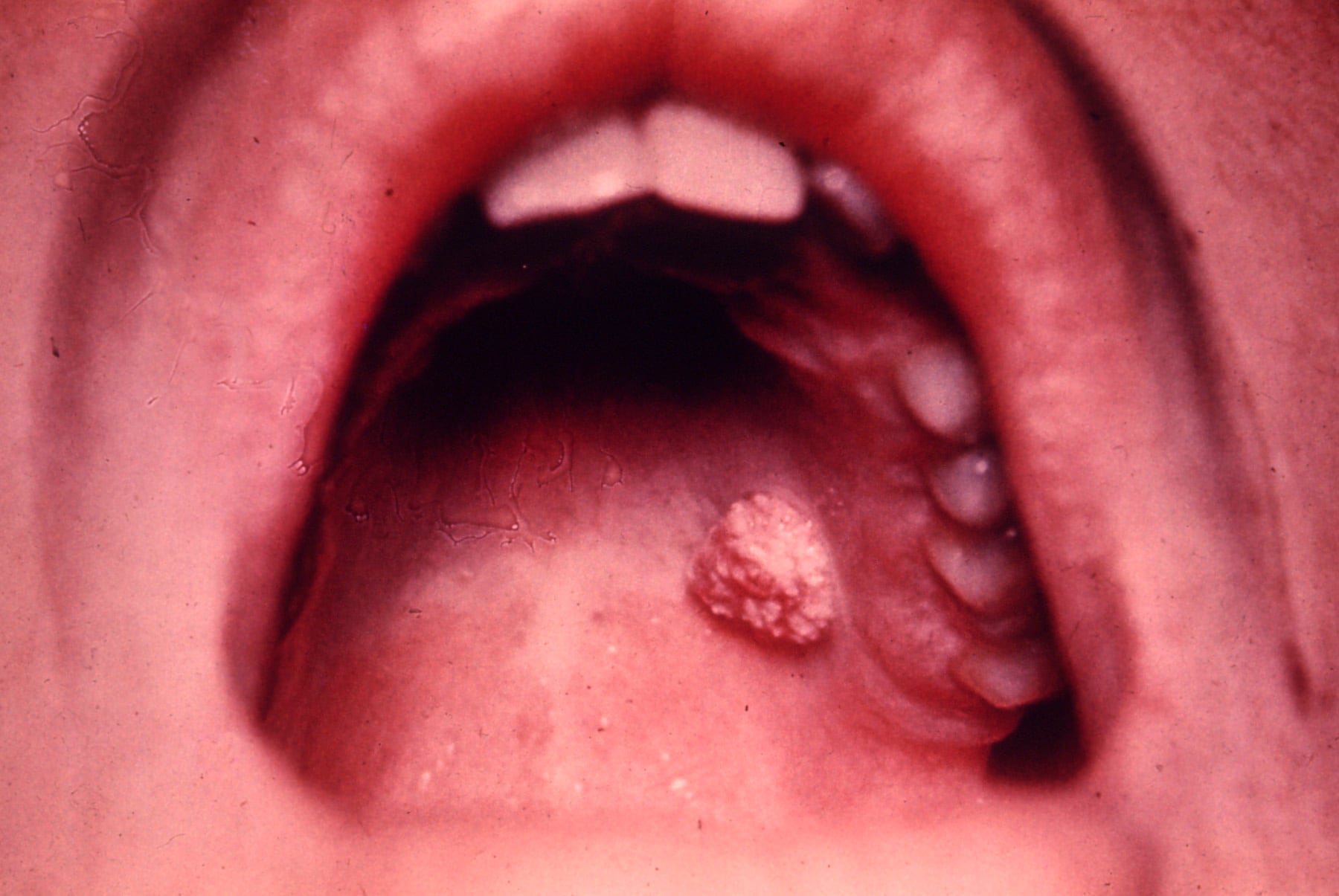Introduction
Background
The use of smokeless tobacco is associated with a spectrum of oral cavity lesions, including leukoplakia, speckled leukoplakia, erythroplasia, tobacco-associated keratosis, carcinoma in situ (CIS), verrucous carcinoma, and invasive squamous cell carcinoma (SCC). In addition to oral lesions, smokeless tobacco users are at increased risk for stomach and pancreatic cancers, although the data regarding the risks for pancreatic cancer are mixed, with some studies showing a statistical association.1,2,3,4
The term smokeless tobacco, also known as dip, plug, chew, or spit tobacco, refers to both chewing tobacco (coarse cut) and snuff (fine cut). Snuff may be used in a dry form, which is inhaled nasally, or in the more commonly used moist form, which is placed in the oral cavity. Recently, "pouch" tobacco products have been marketed to the public. This type of tobacco is positioned along the gum line, and the user may swallow the juices, making chewing and spitting unnecessary. In the United States, clean indoor air acts and cigarette excise tax increases have resulted in a coincidental increase in smokeless tobacco use.5
Tobacco-related lesions (smokeless tobacco–related and nicotinic stomatitis) recently comprised 4.7% of all lesions found in 17,235 people examined as part of the Third National Health and Nutrition Examination Survey. Smokeless tobacco users had one of the highest odds of having a lesion present (odds ratio, 3.9).6
Oral leukoplakia (white plaques) is a common physical finding in 40-50% of people who use smokeless tobacco. It is a premalignant lesion, with the risk of malignant transformation to oral cancer varying in relation to the product used. In relation to snuff products, differences in the tobacco species, fermentation process, nicotine content, tobacco-specific N -nitrosamines content, and pH may account for the differences in the reported risk. With most products, the risk appears quite low, whereas Toombak dipping has been associated with a high incidence of oral cancer in the Sudan.7,8 Oral leukoplakia has been shown to regress in as few as 6 weeks with smokeless tobacco cessation.9 Note the image below.
Erythroplasia (ie, erythroplakia, red plaques) is associated with severe dysplasia or malignancy in 80-90% of cases. Because of the high malignancy rate, the threshold for histologic evaluation of erythroplasia should be low.
Speckled leukoplakia is much less common than either leukoplakia or erythroplasia and is distinguished, as the name suggests, by a speckled appearance.
Tobacco-associated keratosis is a predictable lesion that manifests as an area of thickening at the site of habitual placement of snuff or chewing tobacco. Two distinct grading systems are used to classify lesion stage by degree of clinical thickening. The development of a lesion is dependent on the amount, frequency, type, and brand of smokeless tobacco used.
CIS may manifest clinically as leukoplakia, erythroplasia, speckled leukoplakia, or tobacco-associated keratosis.
SCC may arise in areas of oral or speckled leukoplakia, erythroplasia, or verrucous carcinoma. More than 80% of patients with oral SCC smoke, although those who smoke pipes or cigars are at the greatest risk. Overall, SCC accounts for more than 90% of all oral cancers.
Verrucous carcinoma (also known as snuff dipper's cancer) is a type of low-grade, slow-growing, exophytic SCC that arises from regions in the mouth where smokeless tobacco is consistently placed. Lesions rarely metastasize but may recur, and, rarely, they transform into invasive SCCs. Although verrucous carcinoma is not the most common oral lesion found in users of smokeless tobacco, most cases of verrucous carcinoma are diagnosed in habitual users of smokeless tobacco. Note the image below.
Pathophysiology
Oral smokeless tobacco contains numerous carcinogens, including polonium 210, tobacco-specific N-nitrosamines, volatile aldehydes, and polycyclic aromatic hydrocarbons.
An analysis of the nicotine content of 11 brands of popular smokeless tobacco products found that moist snuff has the highest nicotine content, whereas loose-leaf chewing tobacco has the lowest nicotine content.10
Pure nicotine and smokeless tobacco extract have been compared for their oxidative stress actions by measuring the generation of reactive oxygen species. Pure nicotine has been found to be less toxic than smokeless tobacco extract with equivalent amounts of nicotine.11
Approximately twice as much nicotine is absorbed per dose from smokeless tobacco than cigarettes (4 mg vs 2 mg); orally absorbed nicotine also stays longer in the bloodstream. The average can of smokeless tobacco has an estimated nicotine content of 144 mg, equal to 80 cigarettes. Smokeless tobacco that is placed in the mucobuccal folds causes direct damage to the periodontium (eg, gingivitis, periodontal recession) and oral soft tissue.
Frequency
United States
Smokeless tobacco and its associated lesions affect a large number of persons in the United States, with an estimated 7-13 million people who use smokeless tobacco annually. The popularity of oral forms of snuff and chewing tobacco has rapidly increased in North America, especially among white adolescent males, with an increasing national prevalence in this group from 0.7% in 1970 to 7.5% in 1991.
The percentage of male high school students who used smokeless tobacco on at least 1 of the 30 days preceding a Youth Risk Behavior Survey published in 2003 by the US Centers for Disease Control and Prevention (CDC) varied by state. State prevalence rates in order of descending frequency were 21-30% for Alabama, Kentucky, Tennessee, West Virginia, Arkansas, Montana, Wyoming, and Oklahoma; 11-20% for South Dakota, North Dakota, South Carolina, Kansas, Idaho, Mississippi, Alaska, Colorado, Iowa, Indiana, Nebraska, New Mexico, Wisconsin, Ohio, Texas, Missouri, New Hampshire, Michigan and Maine; and less than 10% for Florida, Arizona, Massachusetts, Delaware, Nevada, New York, Rhode Island, and Maryland.
In 1999, the Journal of the American Medical Association published state-specific prevalences of cigarette and smokeless tobacco use among adults compiled by the CDC from the 1997 Behavioral Risk Factor Surveillance System.5 Health behaviors were assessed through a random-digit dialing telephone survey, and responders were asked if they have ever used or are currently using chewing tobacco or snuff. Results of 17 states were published, revealing more than a 6-fold difference in prevalence rates between Arizona and West Virginia (1.4% vs 8.8%, respectively). The states with the highest prevalence rates were West Virginia and Wyoming (the prevalence rates in males were 18.4% and 14.7%, respectively). In males, prevalence rates of 9-12% were reported in Alabama, Alaska, Kansas, Kentucky, and Montana. Smokeless tobacco use among women was less than or equal to 1.7% in all 17 states.
According to the American Cancer Society, approximately 34,360 new cases (24,180 in men and 10,180 in women) of oral cavity and oropharyngeal cancer will be diagnosed in the United States in 2007, and approximately 7,550 people (5,180 men and 2,370 women) will die in 2007 as a result of these cancers. The death rate for oral cancer is higher than that for malignant melanoma, Hodgkin disease, brain cancer, testicular cancer, or cervical cancer, but it has been decreasing over the past 30 years. Oral cancer is 4 times more likely to occur in users of smokeless tobacco than in those who do not use tobacco products. The annual incidence of oral cancer is estimated at 26 cases per 100,000 users of smokeless tobacco.
International
Worldwide, more than 350,000 new cases of oral and laryngeal cancers are diagnosed each year. Rates of oral cancer vary among countries, with Hungary and France having higher incidences than the United States, and Japan and Mexico having much lower rates.
Mortality/Morbidity
- The survival rates associated with oral SCCs vary from 30-100%, depending on the size, the time of diagnosis, and the location of the lesion. Invasive SCC metastasizes via lymphatic spread, usually to the cervical lymph nodes.
- In 1993, Wray and McGuirt12 described a 5-year survival rate of 37% in patients who used smokeless tobacco for 40 years or more.
- Decreased survival rates from smokeless tobacco use are not likely due to oral cancer alone but include other causes of morbidity and/or mortality. Small studies in specific ethnic populations have shown an increased risk of cardiovascular disease.13
Race
Currently, the incidence of oral cancer is slightly more common in blacks than in whites. From 1987-1992, the incidence of oral cancer was 10.4 cases per 100,000 whites and 13.9 cases per 100,000 African Americans.
Sex
Oral cancer is more commonly diagnosed in men than in women. In 2004, 10,270 new male cases of oral and tongue cancer were reported in the United States, compared with 7,130 new female cases.
Age
Smokeless tobacco use usually begins between ages 9 and 16 years. Although the use of smokeless tobacco frequently starts at school age and may continue in middle age, oral cancer is most commonly diagnosed in patients aged 65 years or older. Verrucous carcinoma, specifically, is most commonly diagnosed in men older than 50 years.
The average age of most people diagnosed with cancer of the oral cavity is 62 years, but approximately 30% of these cancers occur in patients younger than 55 years.
Clinical
History
Patients may present asymptomatically, admitting only to the use of smokeless tobacco or to the presence of other predisposing risk factors (eg, use of alcohol, exposure to chronic irritants) for premalignant and cancerous lesions. In more advanced disease, patients may report pain, swelling, or dysphagia.
Physical
Leukoplakia
Leukoplakia refers to a filmy white or yellow patch involving the oral mucosa. The patch may appear translucent or opaque and raised or ulcerated. It may be pumicelike. Leukoplakia is a clinically descriptive term, and other diseases must be ruled out.
Erythroplasia
Erythroplasia appears as a patch with varying degrees of erythema. It most commonly occurs on the floor of the mouth.
Speckled leukoplakia
The lesions are white patches with interspersed areas of erythema. Two thirds of the lesions are located on the buccal mucosa; the tumors are commonly nodular.
Tobacco-associated keratosis
Tobacco-associated keratosis is an ill-defined area of white thickening at the sites at which oral smokeless tobacco is habitually placed; most commonly, these areas involve the mandibular labial and buccal mucosal folds. The continued use of smokeless tobacco causes the affected areas to become corrugated and grayer.
Verrucous carcinoma
The lesions appear as exophytic growths with papillary projections, they may be large at the time of diagnosis, and they can cause local tissue destruction. They appear rough surfaced with a broad-base attachment.
Squamous cell carcinoma
The lesions usually have a mixed red and white appearance, with ulceration or inflammation in some cases. The lesions are most commonly found on the floor of the mouth and on the ventral and lateral surfaces of the tongue. Those cancers associated with smokeless tobacco may arise in differing locations associated with quid placement and/or the buccal folds. Swelling or induration is characteristic of invasive growth.
Causes
Alcohol consumption, cigarette smoking, candidal infection, and poor dentition are causes. Additionally, human papillomavirus (HPV), especially HPV 16, has been implicated in the pathogenesis of 20-30% of oropharyngeal cancers. People with HPV-related oral cancers seem to have a better prognosis than those without HPV infection, and they are less likely to have a history of tobacco and alcohol use. Finally, exposure to chronic irritants (eg, mouthwash, poorly fitting dentures) may be associated with oral mucosal cancer.





The information you have given in the blog really marvelous and more interesting. hcigar templar mod
Trả lờiXóaWasp dudes! Amazing stuff continues the good work. visit site
Trả lờiXóaThese blogs are quite incredible that have provided the best knowledge. black stillare
Trả lờiXóaI was diagnose with genital warts since 2012 i have be taking lot treatment and all i got is outbreak. in 2015 I gave up the treatment because I can't continues wasting time and money on treatment at the end it will not cure me. about 6 weeks ago i did natural research online I had So many people talking good about natural remedy, after the research i was recommended to Dr onokun, And I wrote to him through his email and told him my problem after some conversations with him he gave me natural treatment after 1 week Dr onokun treated me i got cured permanently. and i went to see my doc he confirmed that the diseases has gone out from my body. every patients should know there is 100% natural hpv cure. contact Dr onokun his email address: dronokunherbalcure@gmail.com
Trả lờiXóa